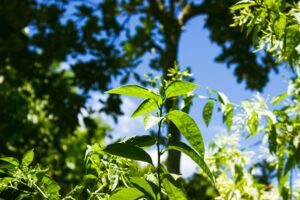Support our educational content for free when you purchase through links on our site. Learn more
[2023] Is it Difficult to Grow Your Own Tea?
Tea-riffic Tea Garden: A Guide to Growing Tea at Home
Table of Contents
- Quick Answer
- Quick Tips and Facts
- Introduction
- How Hard is it to Grow Your Own Tea?
- How Long Does it Take to Grow Your Own Tea?
- Can Tea be Grown in the US?
- What Do You Need to Grow Your Own Tea?
- Camellia Sinensis (Tea Shrub)
- Conclusion
- FAQ
- Recommended Links
- Reference Links
Quick Answer
Growing your own tea can be challenging but rewarding. It requires the right conditions, time, and knowledge. With the right resources and dedication, you can successfully grow your own tea at home.
Quick Tips and Facts
- Tea plants (Camellia sinensis) prefer acidic soil with a pH of 5.5 to 6.5.
- Tea plants thrive in areas with a mild climate and consistent rainfall.
- It takes about 3 to 5 years for tea plants to mature and produce quality leaves.
- Different tea varieties require specific growing conditions, such as temperature and altitude.
- Pruning and proper care are essential for tea plant health and productivity.
- Tea plants can be grown in containers or directly in the ground, depending on available space.
Introduction
Are you a tea lover who dreams of growing your own tea? The idea of sipping a cup of tea made from leaves you cultivated yourself can be incredibly enticing. But is it difficult to grow your own tea? In this article, we'll explore the ins and outs of tea cultivation, providing you with expert advice and tips to help you embark on your tea-growing journey. So, grab your gardening gloves and let's dive in!
How Hard is it to Grow Your Own Tea?
Growing tea is not for the faint of heart, but it's also not impossible. It requires dedication, patience, and a willingness to learn. Here are a few key factors that can make tea cultivation challenging:
-
Climate: Tea plants thrive in areas with a mild climate and consistent rainfall. They prefer temperatures between 50°F and 86°F (10°C to 30°C). If you live in a region with extreme temperatures or a dry climate, you may need to create artificial conditions to ensure the plants' survival.
-
Soil: Tea plants prefer acidic soil with a pH of 5.5 to 6.5. If your soil is alkaline, you may need to amend it with organic matter or use containers filled with suitable soil. Conduct a soil test to determine the pH level and make any necessary adjustments.
-
Time: Growing tea is a long-term commitment. It takes about 3 to 5 years for tea plants to mature and produce quality leaves. During this time, you'll need to provide consistent care, including regular pruning, fertilizing, and pest control.
-
Knowledge: Tea cultivation requires a basic understanding of horticulture and plant care. You'll need to learn about the different tea varieties, their specific growing requirements, and how to process the leaves to make tea. Don't worry, though! There are plenty of resources available to help you along the way.
While these challenges may seem daunting, they can also be part of the excitement and satisfaction of growing your own tea. With the right information and resources, you can overcome these hurdles and enjoy the fruits of your labor.
How Long Does it Take to Grow Your Own Tea?
Growing tea is not a quick process. It takes time for tea plants to mature and produce quality leaves. Here's a general timeline of tea cultivation:
-
Year 1: Planting the Tea Shrub – In the first year, you'll start by planting young tea shrubs or seeds. Focus on establishing healthy plants by providing proper care, including regular watering and protection from extreme weather conditions.
-
Year 2: Growth and Pruning – During the second year, your tea plants will focus on growth. Prune the plants regularly to encourage bushier growth and remove any damaged or diseased branches. This will help shape the plants and promote better leaf production in the future.
-
Year 3: Leaf Production Begins – In the third year, your tea plants will start producing leaves. However, the leaves may not be of the highest quality yet. Continue to prune and care for the plants to improve leaf production and overall plant health.
-
Year 4 and Beyond: Maturation and Quality Leaves – By the fourth year, your tea plants should be fully mature and producing high-quality leaves. This is when you can start harvesting leaves for tea-making. With proper care and maintenance, tea plants can continue to produce quality leaves for many years.
Keep in mind that these timelines can vary depending on various factors, such as the tea variety, growing conditions, and the level of care provided. Patience is key when it comes to growing tea!
Can Tea be Grown in the US?
Yes, tea can be grown in the United States! While tea is traditionally associated with countries like China, India, and Japan, there are regions in the US where tea cultivation is possible. Here are a few key tea-growing regions in the US:
-
Hawaii: Hawaii is known for its thriving tea industry. The state's tropical climate and volcanic soil create ideal conditions for tea cultivation. Some popular tea farms in Hawaii produce high-quality teas enjoyed by tea enthusiasts worldwide.
-
South Carolina: South Carolina has a long history of tea cultivation, dating back to the 18th century. The state's humid subtropical climate and sandy soil are well-suited for growing tea. The Charleston Tea Plantation is one of the most famous tea estates in the US.
-
California: Certain regions of California, such as the Central Coast and the Sierra Nevada foothills, offer suitable conditions for tea cultivation. The state's diverse climate allows for the growth of various tea varieties.
-
Washington State: Washington State's cool climate and fertile soil make it an ideal location for growing tea. The Camellia sinensis plants thrive in the state's Pacific Northwest region, producing unique and flavorful teas.
While tea cultivation in the US may not be as widespread as in other countries, these regions show that it is indeed possible to grow tea on American soil. If you live in one of these areas or have similar growing conditions, you can give tea cultivation a try!
What Do You Need to Grow Your Own Tea?
To grow your own tea, you'll need a few essential items and resources. Here's a list of what you'll need to get started:
-
Tea Plants or Seeds: Start with healthy tea plants or seeds. Choose a tea variety suitable for your climate and growing conditions. You can find tea plants or seeds online or at local nurseries.
-
Suitable Soil: Tea plants prefer acidic soil with a pH of 5.5 to 6.5. Conduct a soil test to determine the pH level and make any necessary amendments. If your soil is not suitable, consider using containers filled with appropriate soil or creating raised beds.
-
Gardening Tools: Invest in basic gardening tools such as a trowel, pruning shears, and a watering can or hose. These tools will help you plant, maintain, and care for your tea plants.
-
Watering System: Tea plants require consistent moisture, especially during the early stages of growth. Consider installing a drip irrigation system or using soaker hoses to ensure your plants receive adequate water.
-
Shade Cloth or Netting: Tea plants prefer partial shade, especially during the hot summer months. Use shade cloth or netting to protect the plants from excessive sunlight and heat.
-
Fertilizer and Organic Matter: Tea plants benefit from regular fertilization. Use a balanced, slow-release fertilizer or organic matter such as compost to provide essential nutrients to the plants.
-
Knowledge and Resources: Educate yourself about tea cultivation. Read books, watch videos, and consult reputable online resources to learn about the specific requirements of the tea variety you're growing. Join online forums or local gardening groups to connect with experienced tea growers and exchange knowledge.
Remember, growing tea requires continuous learning and adjustment. Be prepared to adapt your approach based on the needs of your plants and the specific conditions in your growing area.
Camellia Sinensis (Tea Shrub)
The Camellia sinensis, commonly known as the tea shrub or tea plant, is the species of plant used to produce most of the world's teas. It is a versatile plant that can be grown in various climates and altitudes. Here are a few key facts about the tea shrub:
-
Varieties: There are two main varieties of Camellia sinensis: Camellia sinensis var. sinensis (Chinese tea) and Camellia sinensis var. assamica (Assam tea). Each variety has its own unique characteristics and is used to produce different types of teas.
-
Leaves: The leaves of the tea shrub are glossy, dark green, and elliptical in shape. They have serrated edges and a leathery texture. The size and shape of the leaves can vary depending on the tea variety and growing conditions.
-
Flowers: The tea shrub produces small, white flowers with yellow centers. The flowers are fragrant and bloom in the spring. While the flowers themselves are not used for tea production, they add beauty to the tea garden.
-
Harvesting: Tea leaves are harvested from the tea shrub throughout the growing season. The timing of the harvest depends on the desired type of tea. For example, white tea is made from young leaves and buds, while black tea is made from fully mature leaves.
-
Processing: After harvesting, the tea leaves undergo various processing methods, including withering, rolling, oxidation, and drying. These processes determine the type of tea produced, whether it's green, black, oolong, or white tea.
-
Caffeine Content: The tea shrub naturally contains caffeine. However, the caffeine content can vary depending on factors such as the tea variety, processing method, and brewing time. Generally, green and white teas have lower caffeine levels compared to black and oolong teas.
Growing your own tea starts with selecting the right tea shrub variety for your climate and growing conditions. With proper care and attention, you can enjoy the unique flavors and aromas of homegrown tea.
Conclusion
Growing your own tea can be a challenging but rewarding endeavor. While it may not be the easiest plant to cultivate, with the right conditions, knowledge, and dedication, you can successfully grow your own tea at home. Remember to consider factors such as climate, soil, and time commitment when embarking on your tea-growing journey. And don't forget to enjoy the process and savor the flavors of your homegrown tea!
FAQ
How hard is it to grow your own tea?
Growing your own tea can be challenging, but with the right conditions, knowledge, and dedication, it is possible to successfully grow tea at home. Factors such as climate, soil, and time commitment can make tea cultivation more difficult, but with proper care and attention, you can overcome these challenges.
How long does it take to grow your own tea?
Tea plants take about 3 to 5 years to mature and produce quality leaves. During this time, you'll need to provide consistent care, including regular pruning, fertilizing, and pest control. The timeline can vary depending on various factors, such as the tea variety, growing conditions, and level of care provided.
Can tea be grown in the US?
Yes, tea can be grown in the United States. Regions such as Hawaii, South Carolina, California, and Washington State offer suitable conditions for tea cultivation. While tea cultivation in the US may not be as widespread as in other countries, there are tea farms and enthusiasts producing high-quality teas on American soil.
What do you need to grow your own tea?
To grow your own tea, you'll need tea plants or seeds, suitable soil with a pH of 5.5 to 6.5, gardening tools, a watering system, shade cloth or netting for partial shade, fertilizer or organic matter, and knowledge and resources to learn about tea cultivation. Continuous learning and adjustment are essential for successful tea growing.
Recommended Links
- Shop Tea Plants on Amazon
- Shop Tea Seeds on Amazon
- Shop Gardening Tools on Amazon
- The Charleston Tea Plantation
- Hawaii Tea Society
- Camellia Sinensis Varieties









